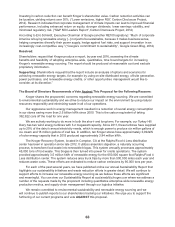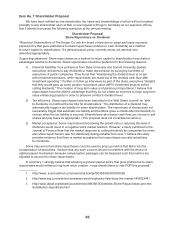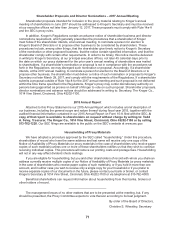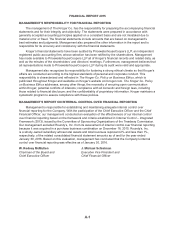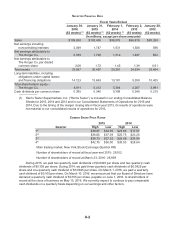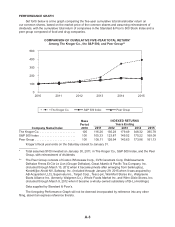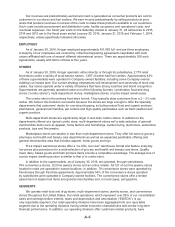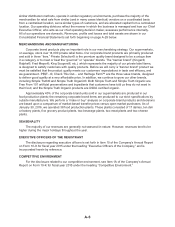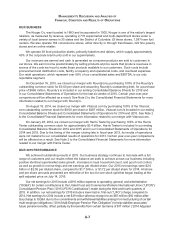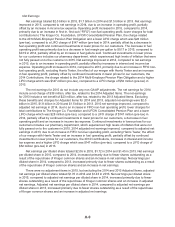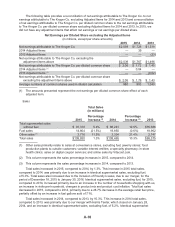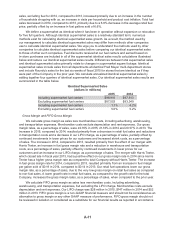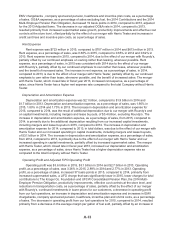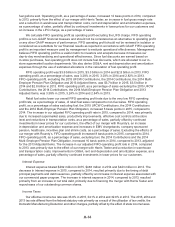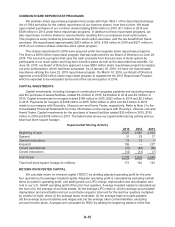Kroger 2015 Annual Report Download - page 79
Download and view the complete annual report
Please find page 79 of the 2015 Kroger annual report below. You can navigate through the pages in the report by either clicking on the pages listed below, or by using the keyword search tool below to find specific information within the annual report.A-5
Our revenues are predominately earned and cash is generated as consumer products are sold to
customers in our stores and fuel centers. We earn income predominantly by selling products at price
levels that produce revenues in excess of the costs to make these products available to our customers.
Such costs include procurement and distribution costs, facility occupancy and operational costs, and
overhead expenses. Our fiscal year ends on the Saturday closest to January 31. All references to 2015,
2014 and 2013 are to the fiscal years ended January 30, 2016, January 31, 2015 and February 1, 2014,
respectively, unless specifically indicated otherwise.
EMPLOYEES
As of January 30, 2016, Kroger employed approximately 431,000 full- and part-time employees.
A majority of our employees are covered by collective bargaining agreements negotiated with local
unions affiliated with one of several different international unions. There are approximately 350 such
agreements, usually with terms of three to five years.
STORES
As of January 30, 2016, Kroger operated, either directly or through its subsidiaries, 2,778 retail
food stores under a variety of local banner names, 1,387 of which had fuel centers. Approximately 42%
of these supermarkets were operated in Company-owned facilities, including some Company-owned
buildings on leased land. Our current strategy emphasizes self-development and ownership of store real
estate. Our stores operate under a variety of banners that have strong local ties and brand recognition.
Supermarkets are generally operated under one of the following formats: combination food and drug
stores (“combo stores”); multi-department stores; marketplace stores; or price impact warehouses.
The combo store is the primary food store format. They typically draw customers from a 2 – 2½ mile
radius. We believe this format is successful because the stores are large enough to offer the specialty
departments that customers’ desire for one-stop shopping, including natural food and organic sections,
pharmacies, general merchandise, pet centers and high-quality perishables such as fresh seafood and
organic produce.
Multi-department stores are significantly larger in size than combo stores. In addition to the
departments offered at a typical combo store, multi-department stores sell a wide selection of general
merchandise items such as apparel, home fashion and furnishings, outdoor living, electronics, automotive
products, toys and fine jewelry.
Marketplace stores are smaller in size than multi-department stores. They offer full-service grocery,
pharmacy and health and beauty care departments as well as an expanded perishable offering and
general merchandise area that includes apparel, home goods and toys.
Price impact warehouse stores offer a “no-frills, low cost” warehouse format and feature everyday
low prices plus promotions for a wide selection of grocery and health and beauty care items. Quality
meat, dairy, baked goods and fresh produce items provide a competitive advantage. The average size of
a price impact warehouse store is similar to that of a combo store.
In addition to the supermarkets, as of January 30, 2016, we operated, through subsidiaries,
784 convenience stores, 323 fine jewelry stores and an online retailer. All 121 of our fine jewelry stores
located in malls are operated in leased locations. In addition, 78 convenience stores were operated by
franchisees through franchise agreements. Approximately 54% of the convenience stores operated
by subsidiaries were operated in Company-owned facilities. The convenience stores offer a limited
assortment of staple food items and general merchandise and, in most cases, sell gasoline.
SEGMENTS
We operate retail food and drug stores, multi-department stores, jewelry stores, and convenience
stores throughout the United States. Our retail operations, which represent over 99% of our consolidated
sales and earnings before interest, taxes and depreciation and amortization (“EBITDA”), is our
only reportable segment. Our retail operating divisions have been aggregated into one reportable
segment due to the operating divisions having similar economic characteristics with similar long-term
financial performance. In addition, our operating divisions offer customers similar products, have



